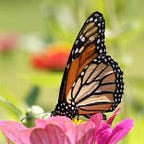FWS Scholar: Melissa Althouse
Melissa Althouse grew up on the South Shore of Massachusetts, just south of Boston, and vacationed to Cape Cod over the summers. Melissa’s passion for conservation came later on, but as a kid she loved to play outside. Maybe it was annual camping trips with the family that planted the seed for her love of nature.
Melissa went to college at Green Mountain College in Vermont, spent some time working down in New Mexico with the Bureau of Land Management, and went on for a graduate degree at the University of New York: College of Environmental Science and Forestry. Her Master’s research focused on studying Roseate terns (Sterna dougallii) and evaluated the impacts of anthropogenic disturbance on these long-distance migrants during the staging period. Much of Melissa’s research is focused on terns including: “Quantifying the Effects of Research Band Resighting Activities on Staging Terns in Comparison to Other Disturbances” and in the Journal of Ecology and Evolution, “Begging behavior as an honest signal of need and parent-offspring association during the postfledgling dependency period.”
Roseate tern numbers were hugely impacted by the hat-making trade in the late 19th century. Now they experience different threats at various times in the annual cycle. While breeding, they primarily feed on American sand lance, a small marine fish. Their nesting success rates may be related to the abundance and proximity of sand lance. During their pre-migratory staging period, when they leave the breeding colonies and congregate on Cape Cod to feed on these fish, it perfectly coincides with tourist season. Everyone, birds and people, want to be on the beaches.
The terns use the intertidal zone between the water and the dunes, spits (sandy extensions of beaches), and low-tide sandbars. These are the same areas that people set up for a day at the beach. The terns are physically displaced from the highest quality resting zones, and frequently disturbed by beach-goers, dogs, and vehicles when they do find an alternate area. Other threats they face include development on barrier islands, competition and predation at breeding colonies, and climate change (sea level rise, warming oceans changing prey populations). Roseate terns are incredibly sensitive to disturbance while breeding, and have been known to abandon entire colonies for lower-quality areas when subject to predation.
Although Roseate Terns travel and forage over a wide expanse of water throughout the staging period, they usually congregate to rest in large numbers in only a few places. The period that Roseate Terns spend staging at Cape Cod National Seashore each year is only a short portion of their life spans, but conditions at staging areas and staging season demography play an important role in the annual cycles of these and other bird species.
Melissa joined the U.S. Fish & Wildlife Service as a Refuge Biologist at Erie National Wildlife Refuge in Pennsylvania. “I’m a jack-of-all-trades,” Melissa says, explaining her work though she’s generally specialized in birds and wetland vegetation. At Erie National Wildlife Refuge, Melissa did a lot of habitat management for early successional obligate species, bats, freshwater mussels, and other species of special concern (like the bald eagle and American woodcock).
“I like to joke I’m a reformed gypsy — moving around from place to place…” Melissa says.
She recently transferred to Ecological Services in Arlington, Texas (her 15th move), and she’s determined to stay at least 10 years this time. Her role in Ecological Services involves all the listed species in her part of the state. So far, Melissa has worked on the American burying beetle, black-capped vireo, Devil’s River minnow, golden-cheeked warbler, Texas kangaroo rat, and three Notodontid moths. Melissa’s passion has always been to help conserve the beautiful natural resources of our world, and now she does that by evaluating species for protection under the Endangered Species Act and reviewing projects that have the potential to impact listed species. Her hobbies align pretty well with that career passion, too — she enjoys native and sustainable gardening, painting, DIY and crafts, horseback riding, hiking, and kayaking.
To learn more about Melissa’s research and roseate tern disturbances, read some more of her research published in the Journal of Wildlife Management, “Evaluating response distances to develop buffer zones for staging terns.” For more information on Roseate terns visit the link. Brought to you by the USFWS Conservation Library, #FWSScholar.
